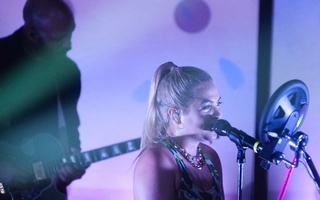{shortcode-931634b48767e0bd88c34de5f88435d8df57c93e}What’s live music? It’s a question that gets asked frequently with respect to electronic music specifically—can you really have a “live” show from an electronic musician if all they do is press play and maybe adjust some levels? A traditionalist might tell you that true live music must include live instruments and some demonstration of technical skill. Some pop-centric idealists will tell you that what happens onstage isn’t nearly as important as the community in the crowd: a group of people who love the same music dancing to remember and/or forget. Those two intersect at a crucial point—a point where gifted musicians wield the power that only they bear to create a meaningful community that didn’t quite exist beforehand—and Jamie xx gave Governors Ball a set that hit that sweet spot on the nose.
Creating this community isn’t as simple as selling a lot of records and relying on those to draw some sort of distinctive crowd. It’s about what you do with that crowd once they get there, and Jamie’s set on Friday evening in the big Bacardi tent demonstrated an intuitive understanding of that. One of the most intriguingly jarring moments of the set was when the DJ played a lightly edited remix of The Human League’s smash hit “Don’t You Want Me.” That 35-year-old track was probably the most well-known song played all weekend at Gov Ball (if you discount the Prince covers that peppered the weekend), and the arrival of its chorus prompted the crowd to bellow in recognition and joy. Why would Jamie xx possibly want to upstage himself with a track from the ’80s, something that doesn’t quite exude the DJ’s style? Perhaps it was a move of inclusion—those in the crowd unfamiliar with the artist whose friends had dragged them to the tent would probably recognize this song. After the one-two punch of “Don’t You Want Me” and an instrumental version of Drake’s recent hit “One Dance,” spaced out eyes turned into bobbing heads.
That’s not to say that the set prioritized inclusivity at the price of disappointing hardcore fans—in the end the set pulled off the miracle of pleasing every demographic. “I’ll Take Care of U,” which Jamie originally wrote for an album he released with Gil Scott-Heron and which was later reworked into the Drake/Rihanna track “Take Care,” served as the perfect pivot between the DJ’s effort to satisfy fans at every end of the spectrum. The melancholy “Take Care” guitar riff is instantly recognizable and sent the crowd further into a frenzy. Casual fans could enjoy a classic 2010s pop song, and serious fans could appreciate the DJ’s long relationship with the song. Jamie also played an instrumental, the only vocals being the “ah-hah ah-hahh” of Scott Heron that appears on both versions of the track. When “I Know There’s Gonna Be (Good Times),” the lead single off Jamie’s debut studio album, “In Color,” came on to close out the show, there were as many people singing along as had sung along to the classics earlier in the show. Jamie took a few modest, thankful bows and stepped off the characteristically fogged-up, intimate stage.—Staff writer Michael L. McGlathery can be reached at mlmcglathery@gmail.com.
Read more in Arts
Governors Ball 2016: Mila's Friday Sound BitesRecommended Articles
-
Foot-Stomping Canadian RockWhen Great Big Sea takes the stage, none of the world’s problems seem to matter any more. Which is important
-
 The Stories Behind the Sound: DJs at Harvard
The Stories Behind the Sound: DJs at Harvard -
'The State of Hip Hop' Is More Business-Minded Than EverThe panelists shed light on how they’ve adapted to hip hop’s changing landscape, emphasizing the importance of how both a passion for music and a mind for business are equally important nowadays to succeed in the industry.
-
From Boston Calling 2018: Friday Sound BitesOn the first day of Boston Calling, Chicago rapper Noname made it halfway through a song into her Friday afternoon set on the Green Stage before she stopped the band, turned to the audience, and said “I’m going to be completely transparent, I am a little bit drunk.”
-
 Hayley Kiyoko Rules the Screen, the Stage, and Societal ‘Expectations’
Hayley Kiyoko Rules the Screen, the Stage, and Societal ‘Expectations’













